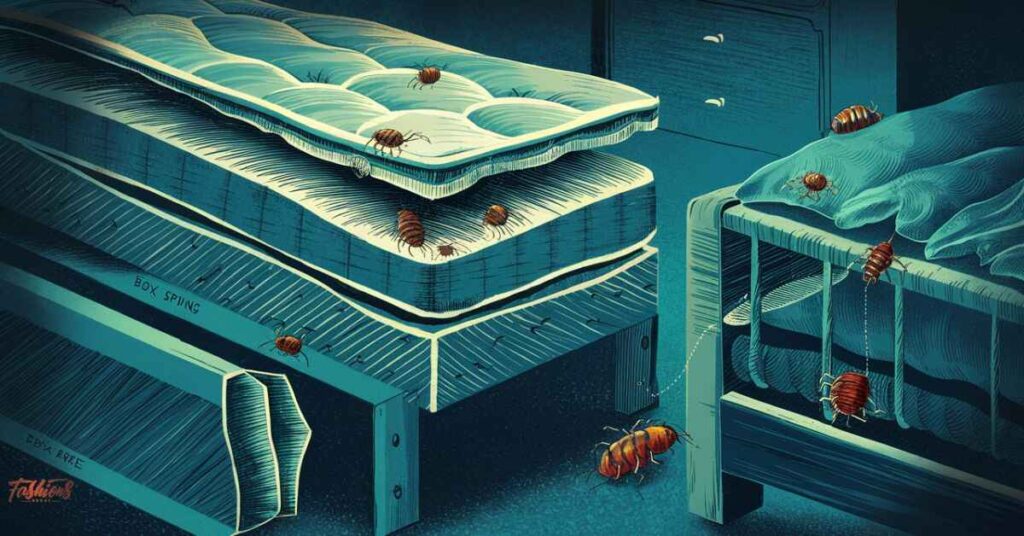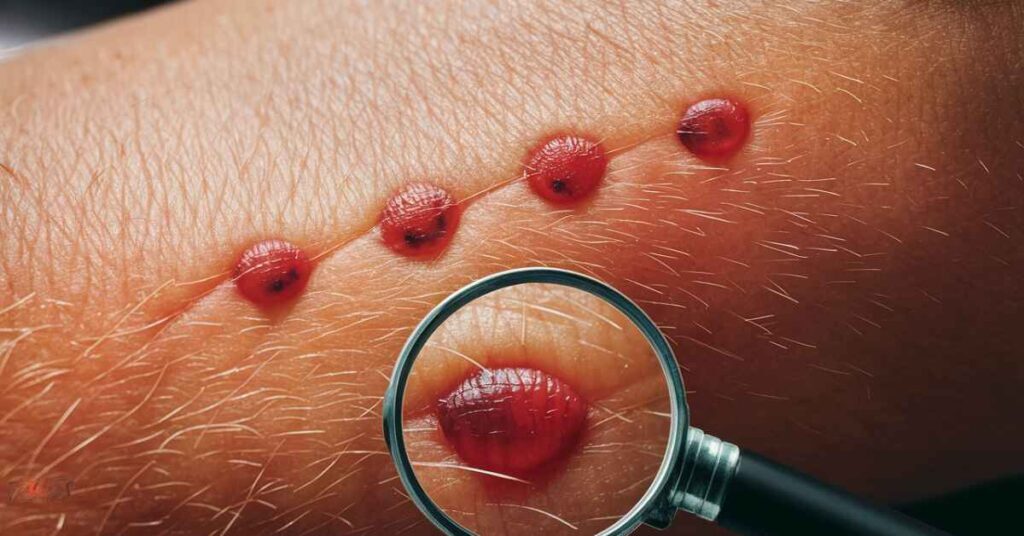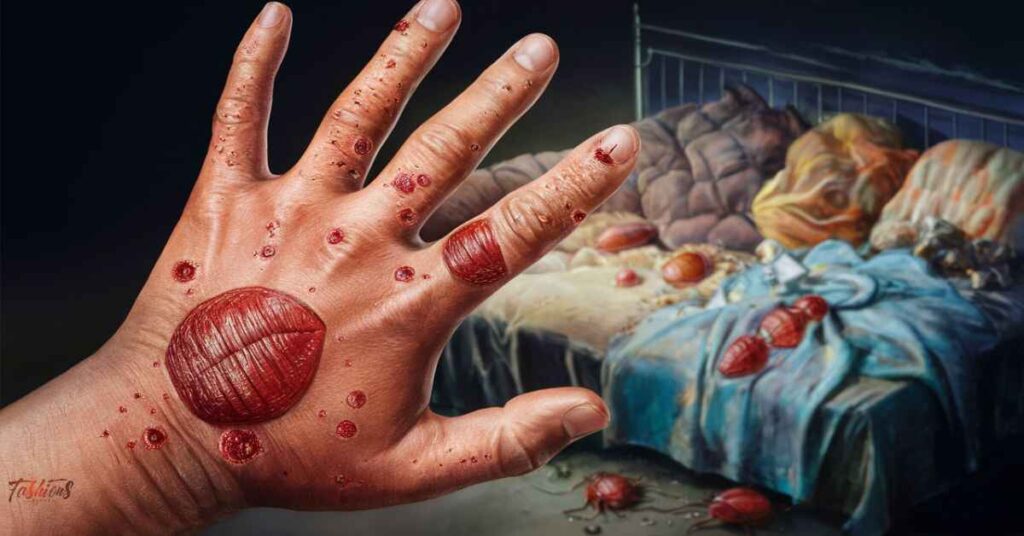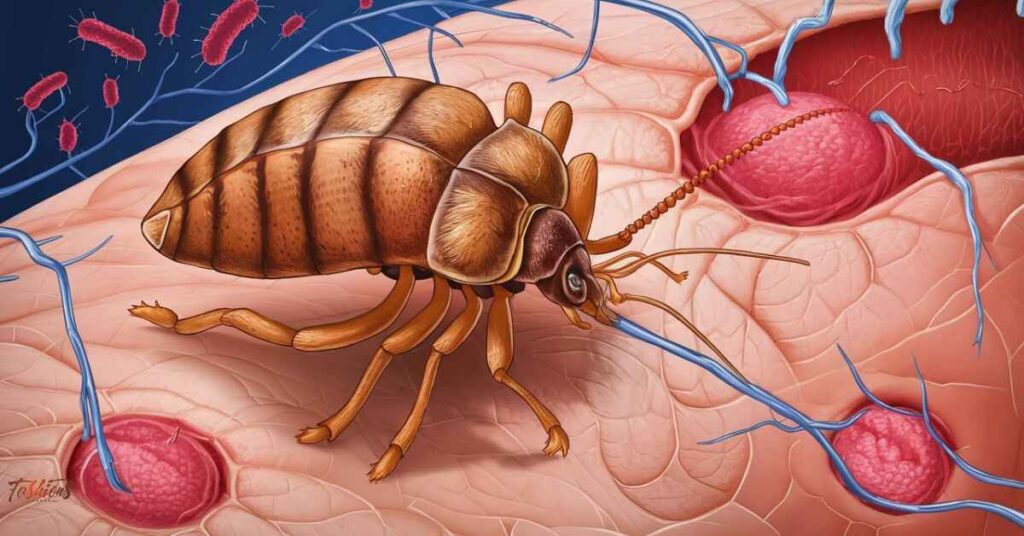The relationship between bedbugs and skin is a complex interplay of biology and behavior. Bedbugs, small parasitic insects, have a profound impact on human skin due to their feeding habits. These pests feed exclusively on blood, typically at night while their hosts sleep.
The skin serves as their primary source of nourishment, and their bites can result in various reactions, from mild itching to severe allergic responses. Understanding this relationship is crucial for effectively managing infestations and mitigating the potential health risks associated with bedbug bites.
Awareness of their behaviors and their effects on the skin can empower individuals to take proactive measures for prevention and treatment.
Quick facts about bedbugs
- Scientific name: Cimex lectularius
- Size: About the size of an apple seed (5-7mm long)
- Color: Reddish-brown
- Lifespan: Can live up to a year with ideal conditions
Bedbugs go through five nymph stages before reaching adulthood. They need a blood meal to molt and grow. A female bedbug can lay up to 500 eggs in her lifetime. That’s a lot of potential for infestation!
What Do Bedbugs Look Like?

Spotting bedbugs isn’t always easy, but knowing what to look for can help.
Adult bedbugs
- Oval-shaped and flat (unless they’ve just fed)
- Reddish-brown color
- About the size of an apple seed
Nymphs (young bedbugs)
- Smaller than adults
- Lighter in color, almost translucent
- Harder to spot due to their size and color
Bedbug eggs
- Tiny, about the size of a pinhead
- Pearly white in color
- Often found in clusters
Remember, these are masters of hide-and-seek. They’re nocturnal and only come out when they sense a meal nearby.
Identification: Spot the Sneaky Invaders
Identifying them can be tricky. They’re often confused with other insects like carpet beetles or ticks. Here’s what sets bedbugs apart:
- Size and shape: Bedbugs are flat and oval, about 5-7mm long
- Color: Reddish-brown, darker after feeding
- Movement: They don’t fly or jump, only crawl
- Smell: They emit a sweet, musty odor
Pro tip: Use a flashlight and magnifying glass when inspecting. These are small and good at hiding!
Where to Find Them: The Hiding Spots of Bedbugs

Bedbugs are expert hiders. They love dark, cozy spots close to their food source (that’s you!).
Common hiding places include
- Mattress seams and tags
- Box springs
- Headboards
- Bed frames
- Cracks in furniture
- Behind loose wallpaper
- Under carpets near baseboards
It can spread easily. They hitch rides on luggage, furniture, and even clothing. That’s why they’re common in hotels, dormitories, and apartment buildings.
How to Check for Bedbugs: Be Your Own Detective
Regular inspections can catch a bedbug problem early. Here’s how to check:
- Strip your bed and examine all seams and folds of the mattress
- Check the box spring, bed frame, and headboard
- Look in and around nearby furniture
- Inspect walls, especially behind pictures and posters
- Check your closet, focusing on the folds of clothes
Tools that can help
- Flashlight
- Magnifying glass
- Credit card (to scrape along seams)
- White sheet (to catch any falling bugs)
If you’re still unsure, consider hiring a professional pest control company for an inspection.
Early Signs of Bedbugs: Catch Them Before They Catch You
Spotting bedbugs early can save you a lot of trouble. Look out for these signs:
- Small blood stains on your sheets or pillowcases
- Dark or rusty spots of bedbug excrement on mattresses and walls
- Bedbug fecal spots, egg shells, or shed skins in areas where they hide
- An offensive, musty odor from the bugs’ scent glands
Remember, seeing live bedbugs is a clear sign of infestation, but they’re good at hiding. These other signs can alert you to their presence before you spot the bugs themselves.
Bite Symptoms: The Telltale Signs
Bedbug bites can be a dead giveaway, but they’re not always obvious. Here’s what to look for:

- Small, red, itchy bumps on the skin
- Often appear in a line or cluster
- Commonly found on exposed areas like arms, neck, or shoulders
But here’s the catch: not everyone reacts to bedbug bites. Some people might have no visible signs at all!
What Is the Most Common Spot for Bed Bug Bites?
Bedbugs are opportunistic feeders. They’ll bite any exposed skin, but some areas are more common than others:
- Face
- Neck
- Arms
- Shoulders
Why these areas? They’re often exposed during sleep and easy for bedbugs to reach from their hiding spots in your bed.
How Can Bedbugs Be Harmful to My Health?
While bedbugs aren’t known to transmit diseases, they can still impact your health:
Physical impacts
- Itchy bites leading to excessive scratching
- Possible allergic reactions
- Secondary skin infections from scratching
Mental health effects
- Anxiety and stress
- Insomnia or sleep disturbances
- Embarrassment or social stigma
Don’t underestimate the psychological toll of a bedbug infestation. It’s not just about the bites!
Complications: When Bedbug Bites Turn Serious

For most people, bedbug bites are just a nuisance. But sometimes, they can lead to more serious issues:
- Allergic reactions: Some people may experience severe allergic reactions, including anaphylaxis in rare cases.
- Skin infections: Excessive scratching can lead to secondary bacterial infections.
- Sleep problems: The stress of an infestation can cause insomnia, leading to other health issues.
If you’re experiencing severe symptoms, don’t hesitate to see a doctor.
Read this blog: Can Hair Dye Really Kill Head Lice? An Honest Look At This Popular Remedy
Understanding the Relationship Between Bed Bugs and Black Skin
Bedbug bites can look different on various skin tones. On darker skin:
- Bites may appear darker or purplish instead of red
- Bumps might be less noticeable
- Itching and swelling are still common symptoms
This can make detection trickier, but being aware of other signs of infestation is key.
What Causes Bedbugs?
Let’s bust some myths. Bedbugs aren’t caused by:
- Dirt or poor hygiene
- Poverty
- Specific climates
The real causes of bedbug infestations
- Travel (hitchhiking on luggage)
- Second-hand furniture
- Connecting walls in multi-unit buildings
Remember, anyone can get bedbugs. It’s not a reflection on you or your cleanliness!
Bedbug Myths: Separating Fact from Fiction
There’s a lot of misinformation out there about bedbugs. Let’s clear some up:
| Myth | Fact |
| Bedbugs can fly | Bedbugs can’t fly or jump, only crawl |
| Bedbugs are too small to see | Adult bedbugs are visible to the naked eye |
| Bedbugs only come out at night | While primarily nocturnal, they can bite during the day if hungry |
| Pesticides alone can eliminate bedbugs | A comprehensive approach is needed for effective elimination |
Knowledge is power in the fight against bedbugs!
How to Prevent Bedbugs: Your First Line of Defense

Prevention is always better than cure. Here are some tips to keep bedbugs at bay:
- When traveling
- Inspect hotel rooms thoroughly
- Keep luggage off the floor and bed
- Check your luggage before bringing it into your home
- At home
- Use bedbug-proof mattress and pillow covers
- Reduce clutter to eliminate hiding spots
- Vacuum frequently, especially around the bed
- Be cautious with second-hand items
- Inspect used furniture carefully before bringing it home
- Wash and dry second-hand clothing on high heat
Regular inspections are key. Catch them early, and you’ll save yourself a lot of trouble!
Treatment: Winning the War Against Bedbugs
If you do find yourself facing a bedbug infestation, don’t panic. There are effective treatments available:
DIY methods
- Washing all bedding and clothes in hot water (at least 130°F)
- Using a steamer on mattresses, couches, and other hiding spots
- Encasing mattresses and box springs in bedbug-proof covers
Professional treatments
- Chemical treatments (pesticides)
- Heat treatments (whole-room heating)
- Freezing (Cryonite treatment)
Remember, treating bedbugs often requires multiple approaches. Don’t be discouraged if it takes a few tries!
Frequently asked questions
How do bed bugs look on black skin?
Bed bugs appear as reddish-brown oval-shaped insects, visible on all skin tones.
Are bed bugs attracted to black?
Bed bugs are attracted to body heat and carbon dioxide, regardless of skin color.
What does your skin look like if you have bed bugs?
Bed bug bites typically cause red, itchy welts on the skin, often in a linear pattern.
What is the relationship between bed bugs and humans?
Bed bugs feed on human blood and thrive in areas where people sleep or rest.
What chemical kills bed bugs permanently?
Chemicals like pyrethroids or neonicotinoids are effective at killing bed bugs permanently.
Can I have bed bug bites but not my husband?
Yes, bed bug bites can affect individuals differently, even within the same household.
How to prevent bed bug bites while sleeping?
Use mattress covers, inspect luggage when traveling, and regularly clean bedding to prevent bed bug bites.
Where do bed bugs hide on your body?
Bed bugs often hide in folds of skin, clothing, or bedding, preferring warm areas near blood vessels.
Conclusion
The relationship between bedbugs and skin is a complex interplay of biology and behavior. Bedbugs might be tiny, but they can cause big headaches. What are bedbugs? Bedbugs, scientifically known as Cimex lectularius, are small, wingless insects that belong to the Cimicidae family.
They are ectoparasites, living externally on warm-blooded animals, primarily humans. Bedbugs are nocturnal and feed exclusively on blood, typically preferring human blood. Their flattened bodies allow them to hide in tiny crevices like mattress seams, bed frames, and furniture, making them challenging to detect and eradicate. Despite their name, bedbugs can infest any area where humans spend extended periods.
Understanding their habits and appearance is crucial for effective control and prevention strategies. Now that you know what bedbugs are, how to spot them, and ways to prevent infestations, you’re better armed against these pesky invaders. Remember, anyone can get bedbugs – it’s not about cleanliness or where you live. The key is staying vigilant and acting fast if you suspect an issue. Regular inspections, careful traveling habits, and quick action can save you from a full-blown infestation. If you do find yourself facing a bedbug problem, don’t panic.
There are effective treatments available, both DIY and professional. Stay informed, stay alert, and don’t be shy about seeking help if needed. With the right knowledge and approach, you can keep your home bedbug-free and sleep tight without letting the bedbug’s bite!







